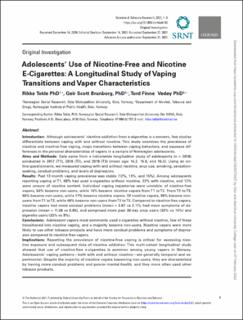| dc.description.abstract | Introduction: Although adolescents’ nicotine addiction from e-cigarettes is a concern, few studies differentiate between vaping with and without nicotine. This study examines the prevalence of nicotine and nicotine-free vaping, maps transitions between vaping behaviors, and assesses differences in the personal characteristics of vapers in a sample of Norwegian adolescents.
Aims and Methods: Data came from a nationwide longitudinal study of adolescents (n = 2018) conducted in 2017 (T1), 2018 (T2), and 2019 (T3) (mean age: 14.2, 15.0, and 16.2). Using an online questionnaire, we measured vaping with and without nicotine, snus use, smoking, sensation-seeking, conduct problems, and levels of depression.
Results: Past 12-month vaping prevalence was stable (12%, 13%, and 15%). Among adolescents reporting vaping at T1, 66% had used e-cigarettes without nicotine, 22% with nicotine, and 12% were unsure of nicotine content. Individual vaping trajectories were unstable: of nicotine-free vapers, 54% became non-users, while 14% became nicotine vapers from T1 to T2. From T2 to T3, 50% became non-users, while 17% became nicotine vapers. Of nicotine vapers, 39% became non-users from T1 to T2, while 46% became non-users from T2 to T3. Compared to nicotine-free vapers, nicotine vapers had more conduct problems (mean = 3.67 vs 2.17), had more symptoms of depression (mean = 11.38 vs 6.95), and comprised more past 30-day snus users (33% vs 14%) and cigarette users (33% vs 9%).
Conclusions: Adolescent vapers most commonly used e-cigarettes without nicotine, few of these transitioned into nicotine vaping, and a majority became non-users. Nicotine vapers were more likely to use other tobacco products and have more conduct problems and symptoms of depression compared to nicotine-free vapers.
Implications: Reporting the prevalence of nicotine-free vaping is critical for assessing nicotine exposure and subsequent risks of nicotine addiction. This multi-cohort longitudinal study showed that use of nicotine-free e-cigarettes is common among young vapers in Norway. Adolescents’ vaping patterns—both with and without nicotine—are generally temporal and experimental. Despite the majority of nicotine vapers becoming non-users, they are characterized by having more conduct problems and poorer mental health, and they more often used other tobacco products. | en_US |

